Anker SOLIX C800 Plus Review
A versatile, high-spec power station for camping





Verdict
The Anker SOLIX C800 Plus strikes a reasonable compromise between portability, and the power and features you need to make the most of a camping weekend. While it’s not a particularly heavy duty supply, it’s more than capable of keeping your gadgets working for several days away from the mains – or longer if you buy it with solar panels. Add in this power station’s flexible lighting, and it could be a great way to make tent or camper van life more civil. Just be mindful that it doesn’t have the outright storage or power to tackle more heavy duty appliances like kettles or some coffee machines.
Pros
- Great design and features
- Useful app control
- Clever, flexible lighting options
Cons
- Lacks the grunt for demanding devices
- Too heavy to carry for long distances
Key Features
- A light-medium duty power stationThe SOLIX C800 Plus stores 768 watt-hours of electricity, and can put out up to 1.2kW. That’s enough to run most gadgets, but not power-hungry appliances like kettles or some microwaves.
- Neat camping lightsThis power supply has a built-in light, and comes with two portable lights and a one-metre telescopic pole stowed away under its lid. There’s a good range of ports, too.
Introduction
This mid-weight power supply from Anker is aimed primarily at campers and recreational users. As such, it needs to hit the sweet spot between features, capacity and portability.
It’s off to a reasonable start, packing 768 watt-hours (Wh) of battery storage into a fairly compact and robust shell, but at nearly 11 kilograms, it’s too heavy to tag along with hikers and bikers – you’ll need a vehicle to get it where you’re going.
The C800 Plus can supply a peak of 1200 watts (1.2kW), and even power some devices rated up to 1.6kW. This power station is more notable, however, for its incredible range of ports and features. In addition to a useful combination of mains, USB and car power ports, it offers a built-in strip light. Pop the lid and you’ll also find two multipurpose camping lights, offering floodlight, candle and flashlight modes. There’s also a one-metre telescopic pole that lets you mount one of the lights above the C800 itself – useful, perhaps, if you want to throw some light on a portable cooker or barbeque.
I’m reviewing the Anker SOLIX C800 Plus, but you can also buy a standard C800. That’s identical, but for a saving of around £50 it comes without the camping lights and pole. While both are suitable for light to medium backup duties in the home, neither really has the puff you’d need to ride out a longer power cut.
Design and features
- Quite portable
- Great packaging
- Very convenient camping lights
The Anker SOLIX C800 Plus is quite similarly specified to the Bluetti AC70, but while the latter is best suited to backup power at home, the C800 is up for a bit of an adventure. While it’s no more portable than the AC70, its lights make it more suited to mobile use, and particularly as a comparatively pokey power supply for nights under canvas.
Pokey it is, at least by mobile standards. Its 1.2kW peak output is plenty for any computers, phones and other lightweight devices you might want to plug in. It may even be enough to run some travel kettles or irons, but if not there’s the ingenious ‘SurgePad’ mode, which can power some simple devices rated up to 1.6kW. This is much like Bluetti’s ‘Heavy Lifting’ mode, in which the voltage is massaged downwards to avoid heavy-duty devices drawing all of their rated power. It’s only suitable for simple resistive loads, such as kettles or toasters.
This power station is very similar in size to the Anker SOLIX C1000, but with fewer batteries inside, it’s a couple of kilos lighter. Two moulded handles make it okay to lug about, but it’s not as easy to carry one-handed as supplies, which have a single handle that runs across the top.
This aside, the C800 Plus is a brilliantly packaged power station. Its AC and DC outputs are all gathered on the front panel, where there’s room for two USB-A sockets rated at 12W each, and two USB-C ports – although only one of these is good for a full 100W output. There’s the ubiquitous 12V car-style output, rated for a maximum 120W, plus three mains sockets. It’s important to note that the 1.2kW maximum is a total, rather than being per-socket.
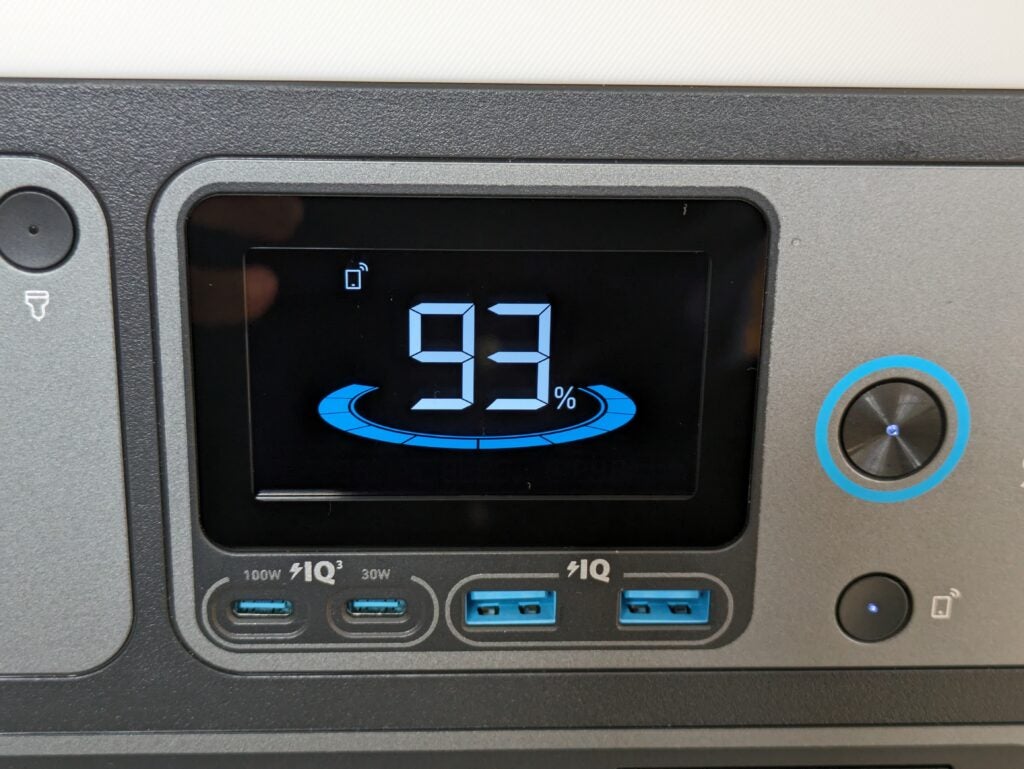
On the left side you’ll find a mains input and reset switch, alongside an XT-60 DC input for solar rated for a 300W maximum. The back panel is blank, while there are cooling vents on each end.
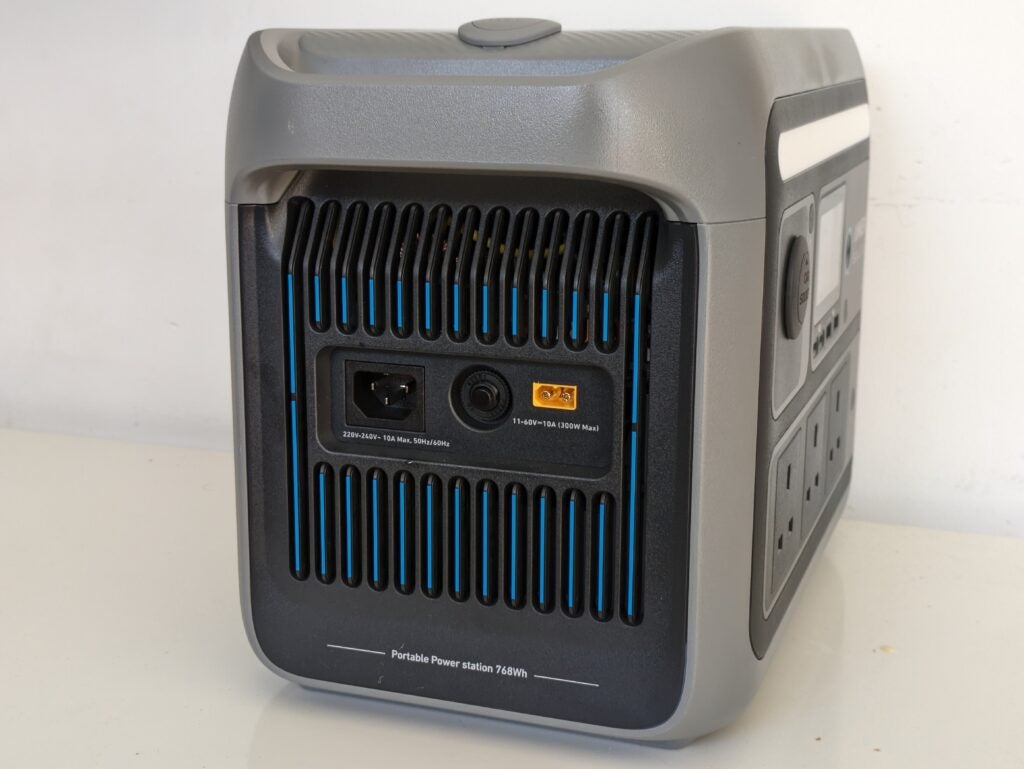
At first glance the C800 Plus’ top panel looks identical to the C1000, but it conceals a tidy compartment for the lights and extendable pole.
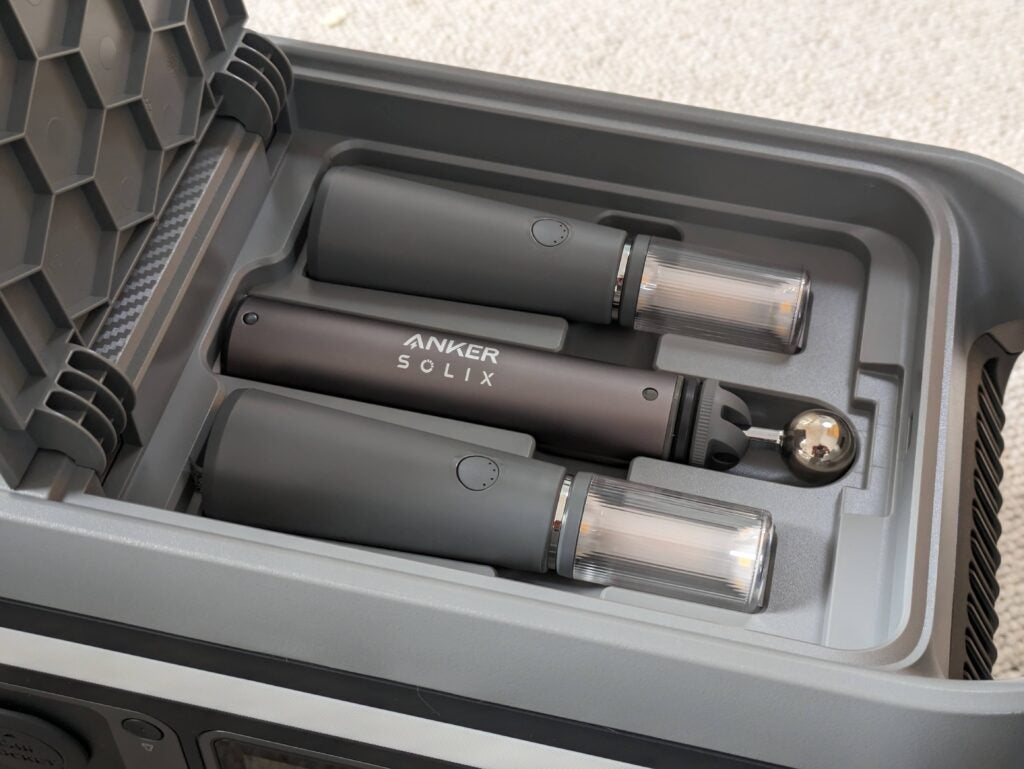
There’s also what looks like another car outlet, but in fact it’s a socket into which you can screw the pole, letting you use the C800 itself as a sturdy base if you need to raise the light up.
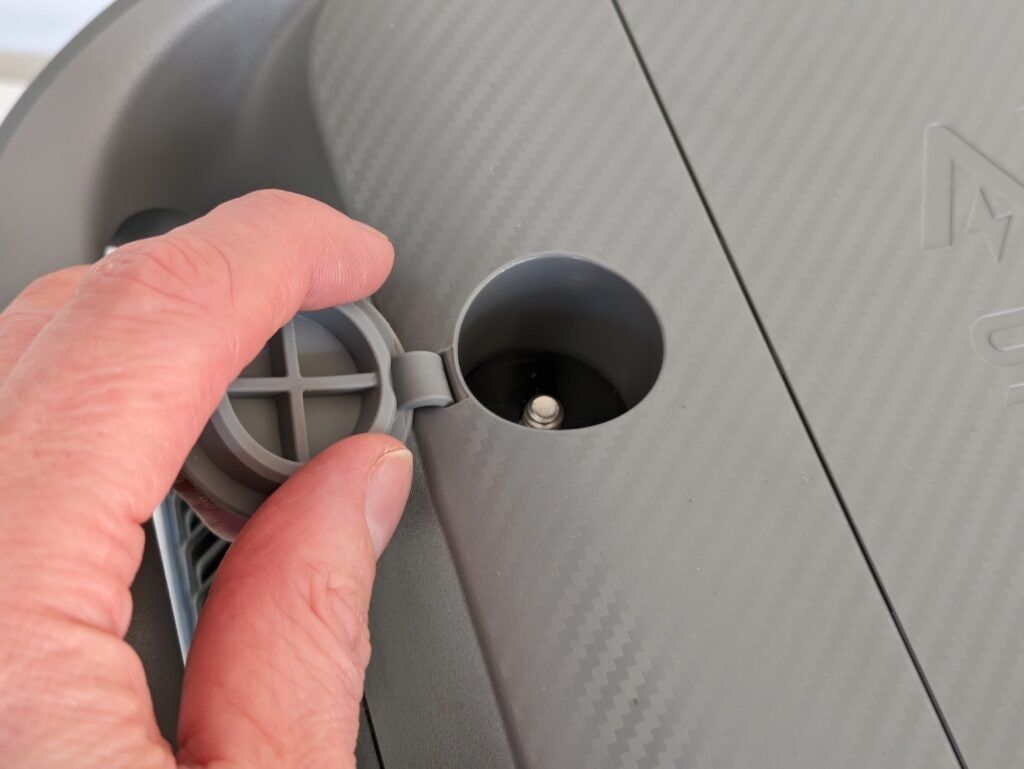
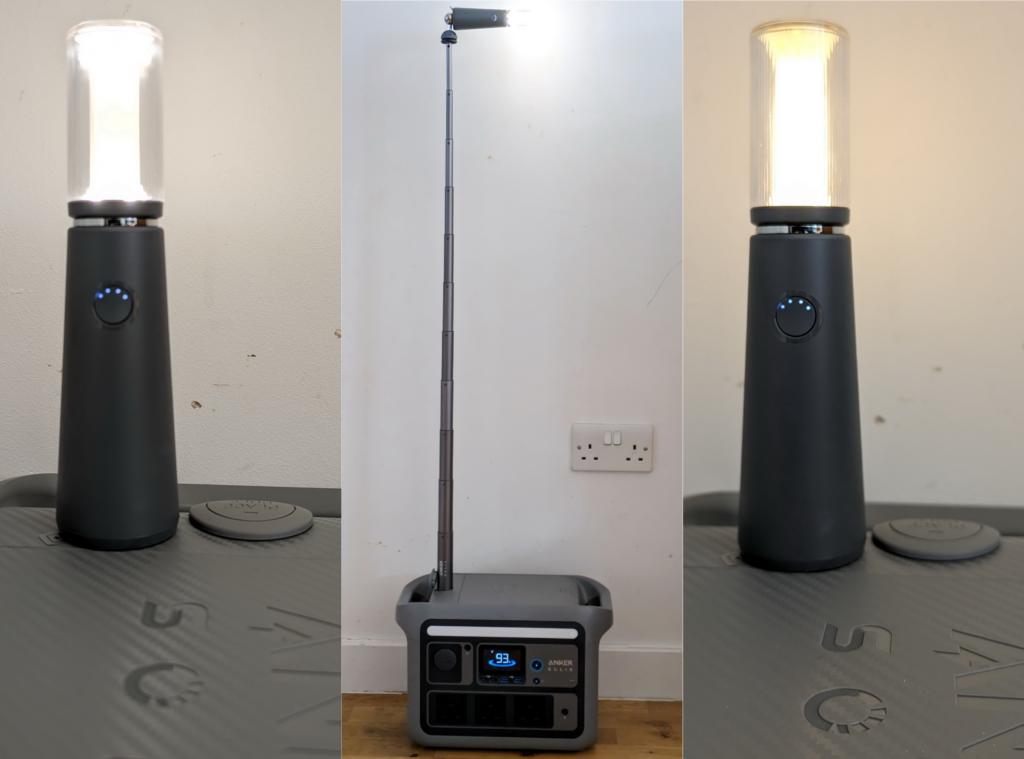
You’re effectively paying a £50 premium over the standard C800 for the lights and pole, so it’s a relief that they seem nicely engineered. The pole’s very light, though it can support loads up to 5kg.
Sensibly, it’s topped by a 1/4-inch thread, so it doubles up as a tripod, although in that mode it offers no adjustment for yaw, roll or pitch. Alternatively, you can screw on the supplied metal ball joint, which lets you attach either light and move it through the almost full sphere of positions.
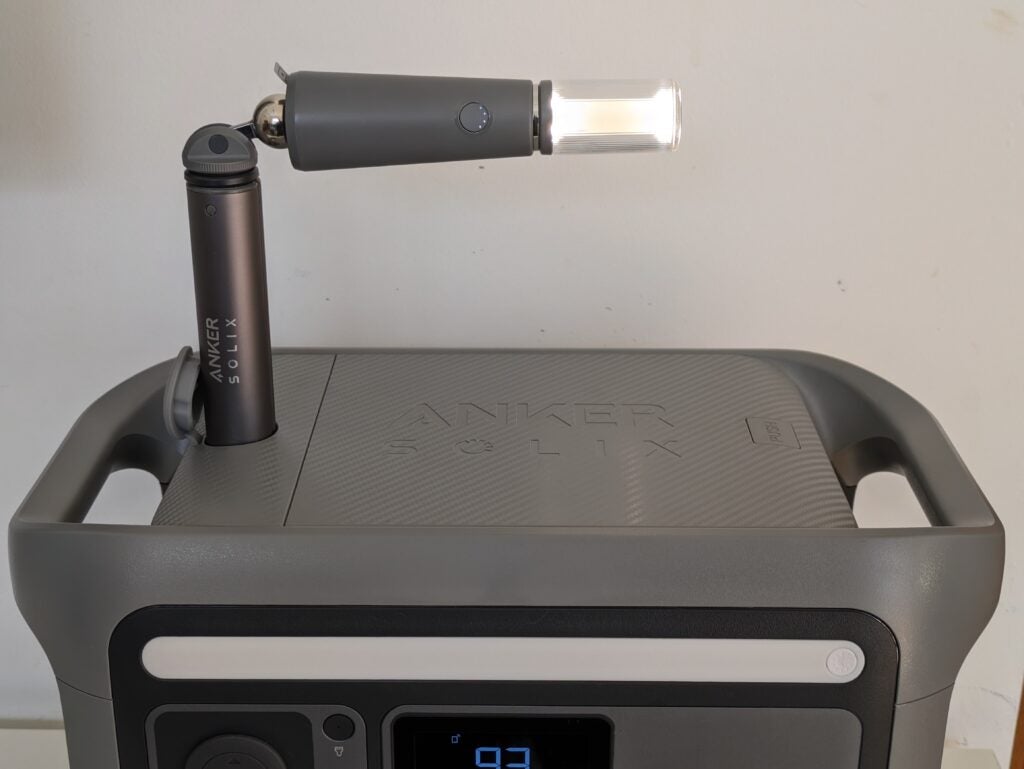
The lights are excellent, although they’re not especially powerful. Each has a single button to toggle through its three modes: flashlight, floodlight, and a yellowish candlelight mode ideal for night time. The comparison below shows the latter two modes, with the C800’s own light on its highest setting.
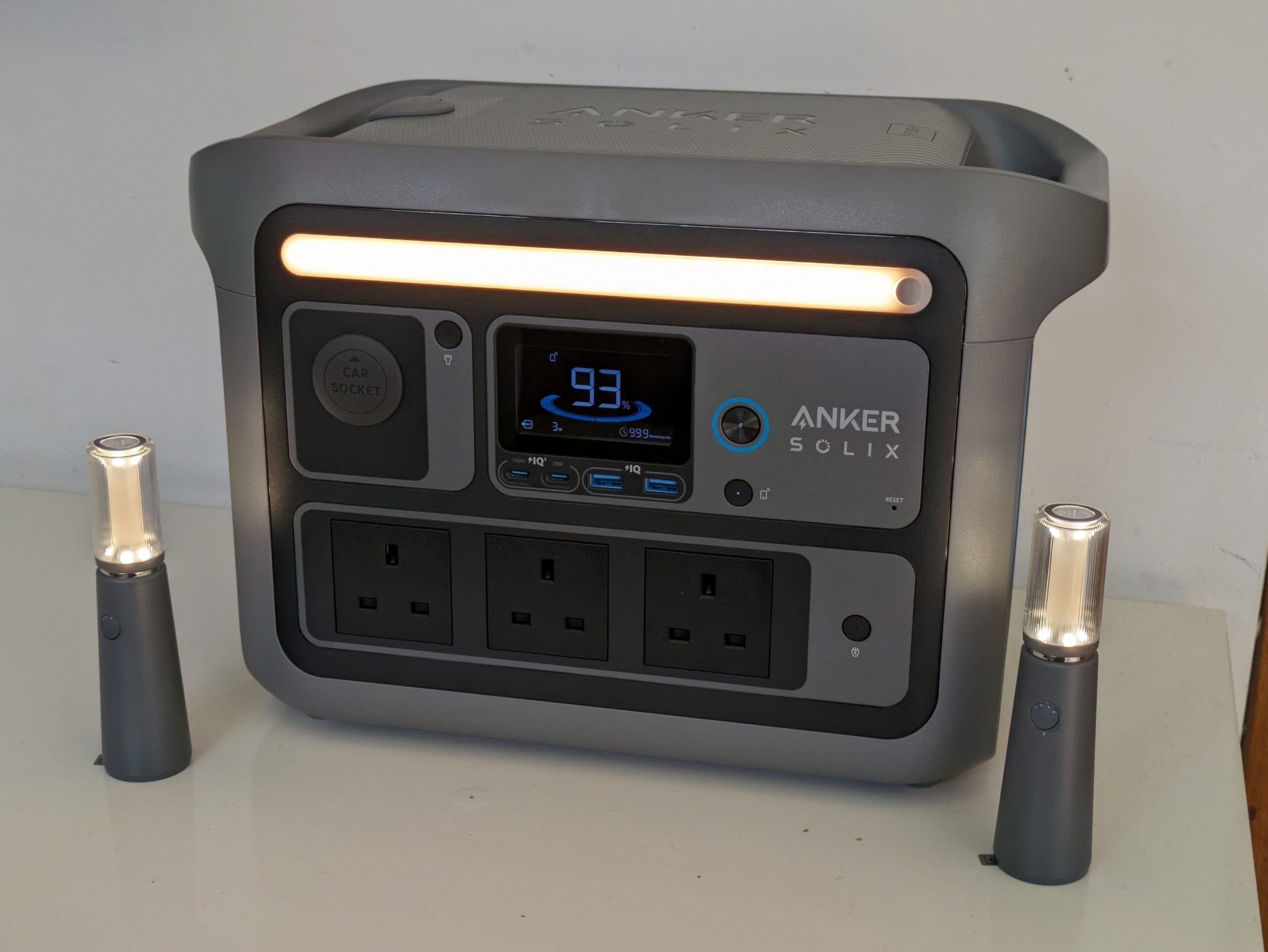
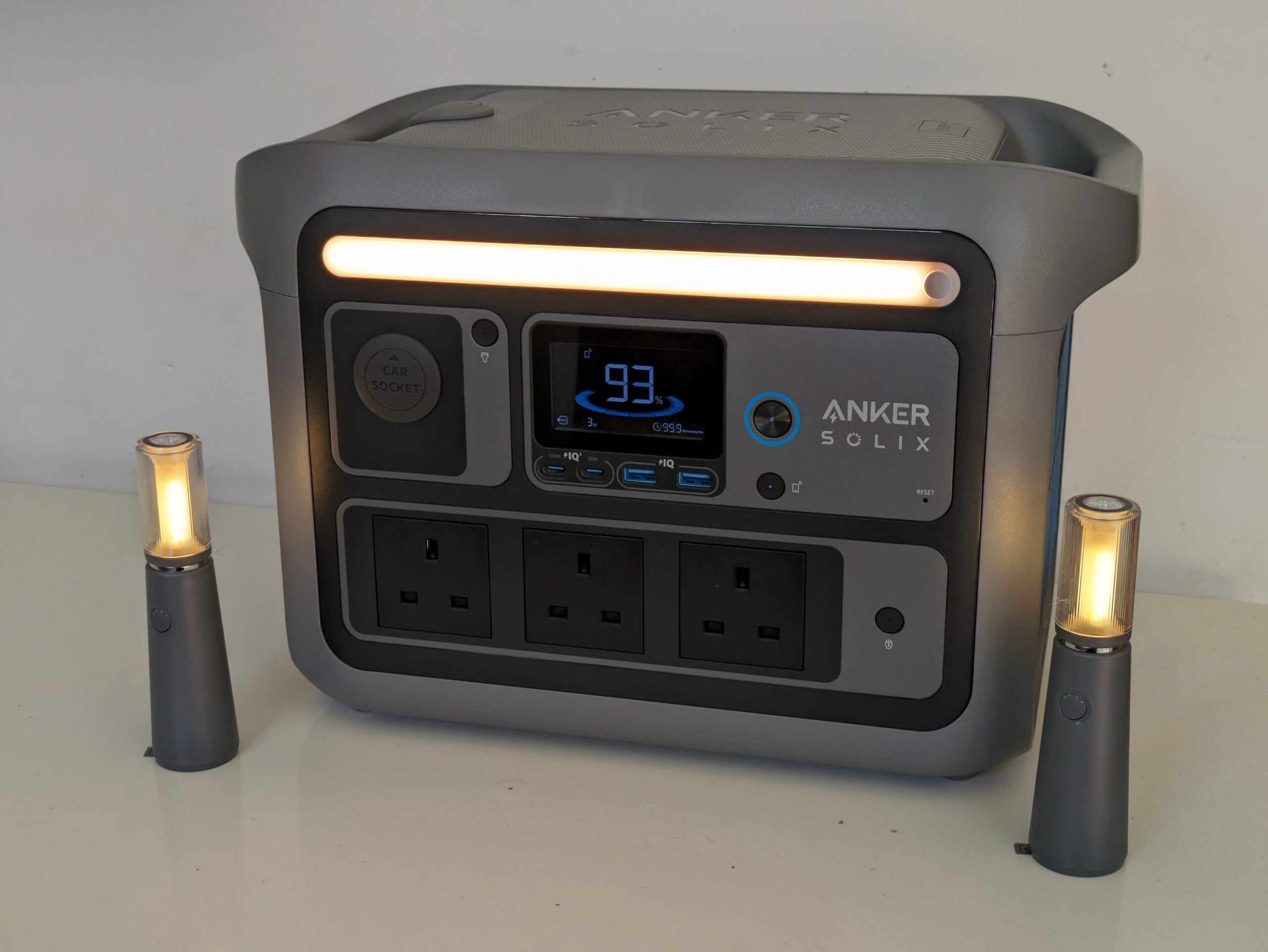
Anker has managed to sneak a metal ring into the base of each light, which you can use to hang them from a tent or carabiner, while four tiny LEDs show their battery charge state at a glance. The power station’s inbuilt light strip has three brightness levels, together with a flashing SOS mode.
The C800 Plus has a decent display, which shows at a glance the battery percentage, along with whether it’s charging, discharging, or neither. There’s an estimate for how long it’ll be before the battery is full or empty, depending on the inputs and outputs you’re using.
As with other SOLIX-branded Anker power stations, you can connect to the C800 via Wi-Fi or Bluetooth, and use the Anker app. This repeats the information that you get from the device screen, but it also lets you switch the car or AC outlets on and off, update the firmware, or tweak preferences such as the display timeout and whether you’re viewing the battery temperature in Celsius or Fahrenheit.
Charging
- Charge from mains, car, or the sun
- Maximum 1100W AC charging
- Lights recharge in their compartment
This is quite a flexible power station when it comes to charging. You can top it up from solar panels or the car using the supplied cable adaptors. It’ll handle up to 300W of solar, or 120W from a car’s cigarette socket. In ideal conditions you’d need to drive for six and a half hours for a full recharge, but with enough panels the sun could get you there in under three. Unfortunately you can’t combine AC and DC sources – the presence of mains power disconnects the car or solar input.
This power station defaults to a 750W charge mode, which fully recharges in just over an hour and a half. Use the app, however, and you can choose various lower power settings down to just 200W, which is useful if you don’t want to overload a generator or low-power electric hookup.
The app also lets you pull the trigger on 1100W UltraFast Charging, using which Anker says you’ll get from 0-100% in just under an hour. I tried this just after a high-power discharge test, and the C800 Plus wouldn’t step above 450W, probably because it was displaying a battery temperature of 50°C. I discharged it and waited for it to cool thoroughly before trying again; this time it finished charging in exactly the specified 58 minutes.
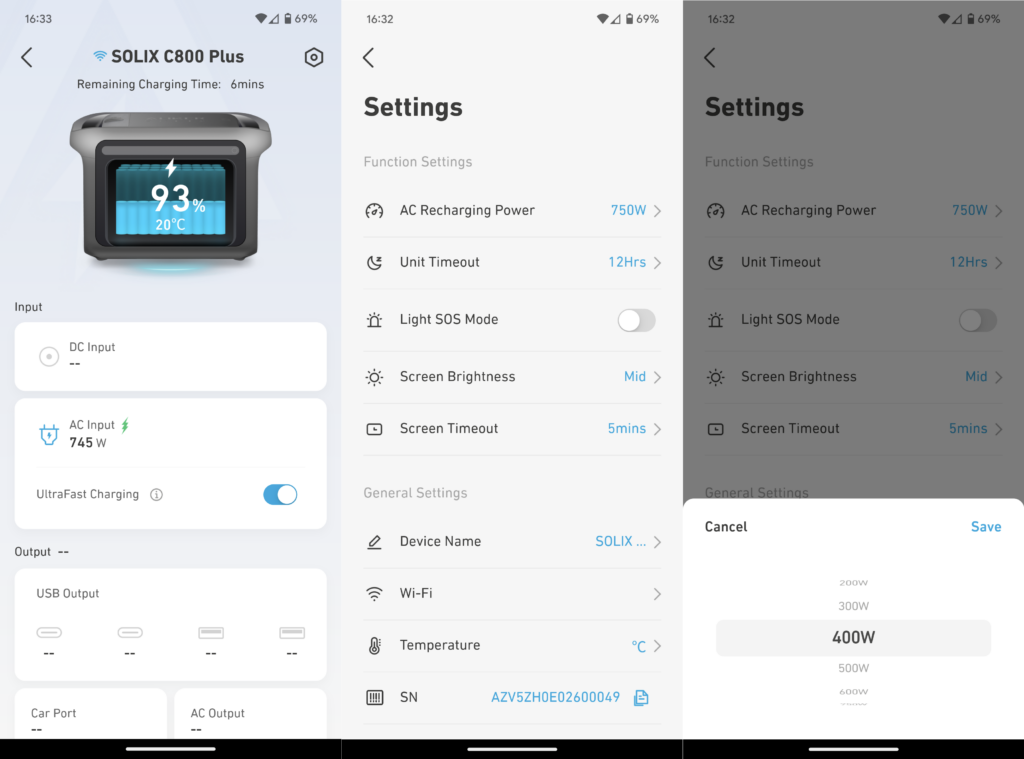
I measured the amount of mains electricity consumed by the C800 Plus during a full recharge. The highest value – 929Wh – was supplied during a 200W charge, and the lowest – 851Wh – came after recharging at 400W. Assuming the 768Wh battery went from fully empty to completely charged, this second value equates to an impressive 90.2% charging efficiency.
Anker says that the C800’s camping lights will run for between 8 and 130 hours, depending on which mode they’re in. They’re recharged automatically in their storage compartment, although only if the C800 Plus itself is switched on.
Performance
- Stable power output, but a bit noisy
- Reasonable efficiency
- Useful SurgePad mode
My first step when testing battery power stations is always to check whether they’ll deliver their maximum rated power. I charged the C800 Plus, connected it to two 600W mains loads (totalling 1200W), and left it to fully discharge over 29 minutes, during which time it supplied 580Wh. This taxing test checks that a power supply will meet its specifications, but it usually also forces its cooling system to work flat out. The C800’s fans are a little loud and quite high-pitched: it’s much harder to background than Bluetti’s comparatively hushed AC70.
I didn’t have a suitable appliance to test this power station’s SurgePad feature, which is aimed at devices rated up to 1600W. To be clear, it’s not designed to supply this much power – instead it adjusts the voltage and maximum current it supplies so that more powerful devices will still work, while drawing no more than the C800’s 1200W maximum output.
I recommend that you never overload any electrical device, but I decided to risk connecting my 1800W kettle. This operated almost normally at first, drawing just under 1600W according to both the C800’s display and my power meter. After about 15 seconds, the C800 reduced this to 1200W. Checking my power meter showed that the AC outlet was now providing 199 volts (down from the mains specification of 230V), and limiting the current to 5.87 amps.
This setup seemed stable enough for my kettle to successfully boil a cup of water, suggesting it would be fine when working within its intended 1600W limit. That could be handy for some travel kettles or coffee makers, but it’s worth stressing that it’s not designed for digital appliances, which might be more sensitive to a non-standard power configuration.
I also tested the C800 Plus with constant 600W, and 200W loads, during which tests it supplied 655Wh and 656Wh respectively. Again, assuming the battery went from full to completely exhausted, that equates to AC efficiency ranging from 75.5% to 85.4%. That’s good, but not as impressive as the AC70, or Anker’s own SOLIX C1000. I also connected the fully charged C800 Plus to a 50W USB-C load. It supplied 666Wh, which works out at a decent 86.7% efficiency.
It’s much more accurate to compare the energy you put in with what you later get out, as this eliminates any guesswork about how much of the actual battery capacity is being used. My best round-trip figures were 77.1% for AC, and 78.3% when discharging via USB. That’s fairly good, but ultimately disappointing given that the C1000 hit 83.3% and 87.6% in the same tests.
Anker says that this power station’s Lithium Iron Phosphate (LFP) batteries should maintain at least 80% of their original capacity after 3000 full charge cycles. Taking the C800 Plus’s full price, and assuming its batteries degrade steadily from new, that equates to 31p per kilowatt hour (kWh) of electricity stored over that time. By comparison, the standard C800 model works out at 29p per kWh, or just 23p when discounted to £599 – as it was briefly during my review.
It’s worth stressing that we calculate these figures to give an indication of long-term value, and that the power station should still be working after 3000 cycles. Indeed, Anker says the C800 Plus is designed for a 10-year lifespan, and it’s backed up by a five-year warranty.
Latest deals
Should you buy it?
You should buy if you want big power for camping
This is an excellent battery power station for people who need to take a reasonable amount of energy on the road. It performs well, is reasonably portable, and has all the ports and features you’re likely to need when camping.
You should not buy if you want to travel light
The Anker SOLIX C800 Plus is too heavy to take on biking or walking trips, and not everyone will need its handy lights.
Final Thoughts
If you’re after a midweight power supply that’s reasonably portable and powerful, the Anker SOLIX C800 Plus could be ideal. It’s got a great selection of ports, stores a fair amount of electricity, and adds in some genuinely useful camping lights. While its 768Wh of storage and 1200W maximum output probably aren’t enough for kitchen gadgets in a caravan, they should be perfect for even a large group going camping for a weekend.
That said, I wouldn’t want to carry this power supply far, and I certainly wouldn’t want it weighing me down on a biking trip. The C800 Plus is probably best suited for people who drive to their camping holidays. Meanwhile, if you’re really more interested in mid-weight backup power in the home, we’d recommend Anker’s SOLIX C1000 or the Jackery Explorer 1000 Plus instead – both add more power output and storage for not a huge amount more outlay.
How we test
We test every battery station we review thoroughly over an extended period of time. We use standard tests to compare features properly. We’ll always tell you what we find. We never, ever, accept money to review a product.
Find out more about how we test in our ethics policy.
We test with a variety of devices to see how long the battery will last.
We test different charging methods to see how quickly the battery can be topped up.
FAQs
The C800 Plus (with lights) weighs 10.9 kilos. The regular C800 is 10.5 kilos.
They’re identical, except that the C800 Plus comes with two rechargeable camping lights and a mounting pole. These are stored and recharged in a hidden compartment which, on the C800, is just for general storage.








